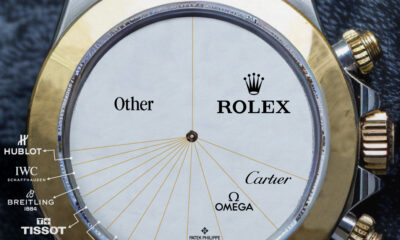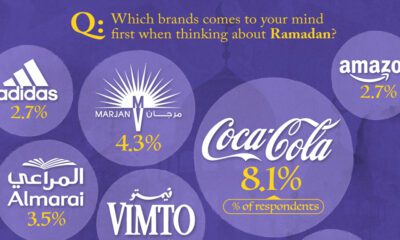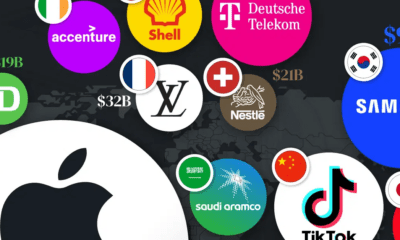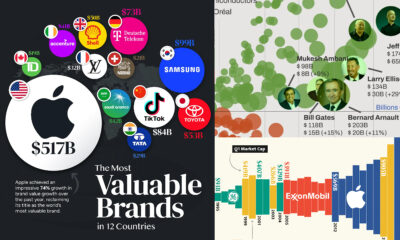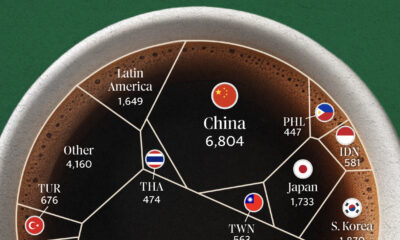Business
Ranked: The 20 Best Franchises to Open in the U.S.

Ranked: The 20 Best Franchises in the U.S.
The U.S. is famous for chain restaurants, franchised shops, and brand name hotels. One thing these franchises aim for is consistency in store feel, customer service, product offerings, and prices, no matter which state you’re in.
This visualization uses Entrepreneur’s annual Franchise 500 Ranking to showcase the best franchises in the U.S. worth owning, from Dunkin’ Donuts to Snap-on Tools.
The Best and How They Were Selected
The report assessed five broad categories to score the country’s famous chains:
- Costs & fees: including franchise fee, total investment needed to open one store, and royalty fees
- Support: including training times, marketing support, operational support, franchisor infrastructure, financing infrastructure, and litigation
- Size & growth: including open & operating units, growth rate, and closures
- Brand strength: including social media, system size, years in business, years franchising
- Financial strength & stability: including franchisor’s audited financial statements
A franchise was only considered if it was actively seeking new franchisees and must have already had at least 10 units operating.
Here’s a closer look at the top 20:
| Rank | Franchise | Initial Investment Needed | Global Units 2022 |
|---|---|---|---|
| #1 | Taco Bell | $576K - $3.4M | 7,900 |
| #2 | Popeyes Louisiana Kitchen | $384K - $3.5M | 3,851 |
| #3 | Jersey Mike's Subs | $194K - $955K | 2,402 |
| #4 | The UPS Store | $122K - $508K | 5,464 |
| #5 | Dunkin' | $438K - $1.8M | 12,957 |
| #6 | Kumon | $67K - $146K | 26,527 |
| #7 | Ace Hardware | $292K - $2.1M | 5,746 |
| #8 | Culver's | $2.3M - $5.8M | 871 |
| #9 | Hampton by Hilton | $12.3M - $22.8M | 2,824 |
| #10 | Wingstop | $315K - $948K | 1,873 |
| #11 | Tropical Smoothie Cafe | $277K - $584K | 1,142 |
| #12 | Arby's | $629K - $2.3M | 3,561 |
| #13 | KFC | $1.4M - $3.2M | 26,498 |
| #14 | McDonald's | $1.4M - $2.5M | 39,696 |
| #15 | Wendy's | $330K - $3.7M | 7,049 |
| #16 | Servpro | $217K - $271K | 2,050 |
| #17 | Smoothie King | $264K - $1.2M | 1,373 |
| #18 | 7-Eleven | $125K - $1.3M | 81,887 |
| #19 | Budget Blinds | $141K - $212K | 1,378 |
| #20 | Snap-on Tools | $201K - $465K | 4,771 |
The number one franchise, Taco Bell, has been in business since 1964 and has 7,900 locations as of 2022, spanning beyond the U.S. to Canada, Australia, Europe, and other regions of the world. The average cost of investment to be a franchisee is between $576,000 to $3.4 million.
While most of the top 20 are in the food service industry, there is also one hotel, one shipping company, and a few hardware and home goods stores that make the list.
Ace Hardware (#7), for example, which specializes in home improvement goods, is actually an international franchise with close to 6,000 units. Kumon (#6) is an education center and is the only non-U.S. franchise on the list.
The Feasibility of Being a Franchisee
To get a better sense of the costs needed to start a franchise, let’s take a look at one of the most famous convenience stores in the world. Here’s a sample of the different fees involved in 7-Eleven’s initial franchisee process:
| Initial Franchise Fee | $0 - $1,000,000 |
| Initial Investment | $125,250 - $1,333,500 |
| Cash Requirement | $50,000 - $250,000 |
| Veteran Incentives | 10-20% off franchise fee, up to $50,000; preferred interest rates and special financing |
| Royalty Fee | Varies |
| Ad Royalty Fee | 1% |
| Term of Agreement | 15 years |
| Is franchise term renewable? | Yes |
In terms of low-cost franchises, 7-Eleven is among one of the cheapest to open, according to Entrepreneur, sometimes costing less than $150K. Other franchises with lower cost barriers of entry include UPS ($122K – $508K) and Cinnabon ($112K – $547K).
There is more to consider than cost, of course, and some franchises provide better support than others in aspects such as financing, industry training, or legal support. Popeye’s, for instance, provides in-house financing for their franchise fee, as well as connections with third-party sources to help cover equipment, inventory, payroll, and other expenses.
Looking at feasibility in regards to opportunities, some of the fastest-growing franchises include chains like Jersey Mike’s Subs and Wingstop. Here’s a closer look at the Franchise 500’s fastest growing list:
- #1 Stratus Building Solutions
- #2 Jersey Mike’s Subs
- #3 Goosehead Insurance
- #4 Signal
- #5 Wingstop
In total there are almost 800,000 franchises in the U.S. The franchise market in the country has an economic output of over $825 billion and employs over 8.4 million people. With many of these franchises continuing to grow and seek new franchisees, there is ample opportunity in the market.
Brands
How Tech Logos Have Evolved Over Time
From complete overhauls to more subtle tweaks, these tech logos have had quite a journey. Featuring: Google, Apple, and more.

How Tech Logos Have Evolved Over Time
This was originally posted on our Voronoi app. Download the app for free on iOS or Android and discover incredible data-driven charts from a variety of trusted sources.
One would be hard-pressed to find a company that has never changed its logo. Granted, some brands—like Rolex, IBM, and Coca-Cola—tend to just have more minimalistic updates. But other companies undergo an entire identity change, thus necessitating a full overhaul.
In this graphic, we visualized the evolution of prominent tech companies’ logos over time. All of these brands ranked highly in a Q1 2024 YouGov study of America’s most famous tech brands. The logo changes are sourced from 1000logos.net.
How Many Times Has Google Changed Its Logo?
Google and Facebook share a 98% fame rating according to YouGov. But while Facebook’s rise was captured in The Social Network (2010), Google’s history tends to be a little less lionized in popular culture.
For example, Google was initially called “Backrub” because it analyzed “back links” to understand how important a website was. Since its founding, Google has undergone eight logo changes, finally settling on its current one in 2015.
| Company | Number of Logo Changes |
|---|---|
| 8 | |
| HP | 8 |
| Amazon | 6 |
| Microsoft | 6 |
| Samsung | 6 |
| Apple | 5* |
Note: *Includes color changes. Source: 1000Logos.net
Another fun origin story is Microsoft, which started off as Traf-O-Data, a traffic counter reading company that generated reports for traffic engineers. By 1975, the company was renamed. But it wasn’t until 2012 that Microsoft put the iconic Windows logo—still the most popular desktop operating system—alongside its name.
And then there’s Samsung, which started as a grocery trading store in 1938. Its pivot to electronics started in the 1970s with black and white television sets. For 55 years, the company kept some form of stars from its first logo, until 1993, when the iconic encircled blue Samsung logo debuted.
Finally, Apple’s first logo in 1976 featured Isaac Newton reading under a tree—moments before an apple fell on his head. Two years later, the iconic bitten apple logo would be designed at Steve Jobs’ behest, and it would take another two decades for it to go monochrome.
-

 Education1 week ago
Education1 week agoHow Hard Is It to Get Into an Ivy League School?
-

 Technology2 weeks ago
Technology2 weeks agoRanked: Semiconductor Companies by Industry Revenue Share
-

 Markets2 weeks ago
Markets2 weeks agoRanked: The World’s Top Flight Routes, by Revenue
-

 Demographics2 weeks ago
Demographics2 weeks agoPopulation Projections: The World’s 6 Largest Countries in 2075
-

 Markets2 weeks ago
Markets2 weeks agoThe Top 10 States by Real GDP Growth in 2023
-

 Demographics2 weeks ago
Demographics2 weeks agoThe Smallest Gender Wage Gaps in OECD Countries
-

 Economy2 weeks ago
Economy2 weeks agoWhere U.S. Inflation Hit the Hardest in March 2024
-

 Environment2 weeks ago
Environment2 weeks agoTop Countries By Forest Growth Since 2001


